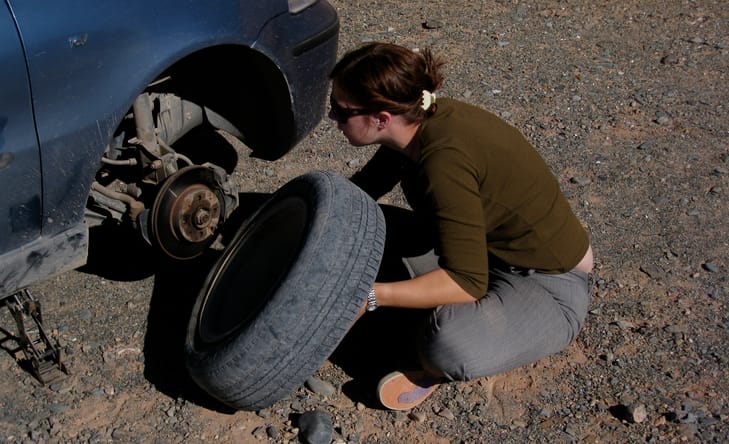Don’t Know How To Change A Tire? That’s Not a Bad Thing

Why I Won’t Learn to Change a Tire, and You Don’t Need To, Either.
It was a point of pride when I was a young new driver: I learned to change a tire. And I hated every minute of it. The tools were greasy and the tires were heavy. The process would ruin the clothes I was wearing and my poor skinny arms would shake at the thought of lifting a heavy tire—they can weigh 70 pounds and are hard to get your arms around. But I did it because ruining an outfit was often preferable to being stuck on a cold dark roadway with no one to help me. That was back in the day before cell phones and before I could afford an AAA membership.
But as I drive my family around on winter-pockmarked roads, I have to wonder: how much damage is being done to my tires? And, will I get caught with a flat tire on the road side? And if so, what will I do?
These days there is almost no reason to learn to change a tire.
Here’s why:
-Most new cars come with a roadside assistance package and often it’s standard; if you have a flat you can call the service line and a service technician will come change it for you.
-Most insurance plans offer road side assistance for a low annual fee.
-AAA (the American Automobile Association) allows you up to four road side assistance calls per year free.
-The hydraulic tools that mechanics use to tighten the lug nuts on your tires means it takes a lot of strength to loosen them. I found this out a few years ago when I had a flat and had to call a tow truck; I tried and tried and couldn’t loosen the lug nuts.
-Tire pressure monitor sensors (TPMS) on most new cars will give you a heads up that your tires need attention. This also means that you can replace your tires with run flat tires and will likely never get stuck with a flat. If your car is older and doesn’t have TPMS, you can get a kit at the auto parts store for under $200.
-Innovations in tires mean that they will perform better, last longer and need less attention from drivers. A new generation of run flats that drive more comfortably and are less expensive are on the way to tire stores soon, and Michelin’s new A/S line, engineered to maintain or improve its performance as it wears down will add life and enhanced safety to the life of the tire.
Not learning how to change a tire doesn’t mean you don’t need to be prepared. You should know what type of tires you have, monitor their condition, make sure they are properly inflated, and have a plan for when you have an issue—a roadside assistance plan or an AAA membership. And of course, if you’re going somewhere that service might not be available, such as the Peruvian mountains or the Australian outback, it’s a good skill to have. But convenience and peace of mind of a back up plan is a great thing. Because never having to change a tire is an even better thing.
